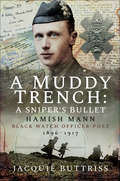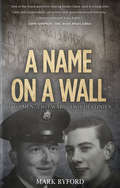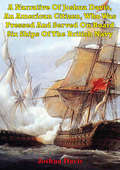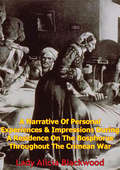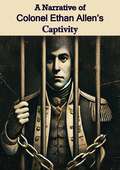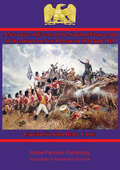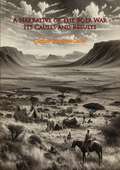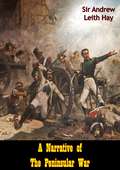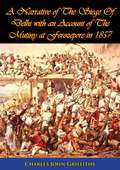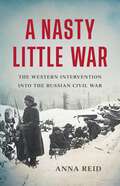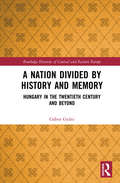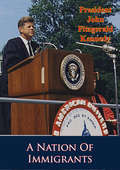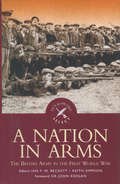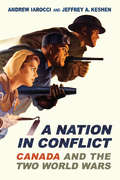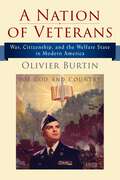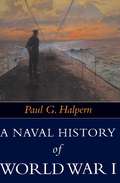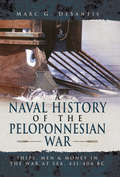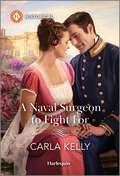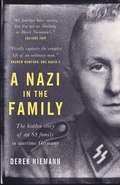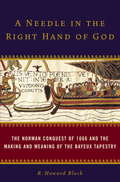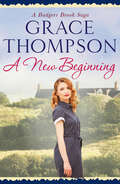- Table View
- List View
A Muddy Trench: Hamish Mann, Black Watch, Officer-Poet, 1896–1917
by Jacquie ButtrissThe recent discovery of a wooden chest, unopened for 100 years revealed a treasure trove of eloquent trench diaries, letters and poetry. The author was Hamish Mann, a young Black Watch subaltern killed in France in 1917 just five days after his 21st birthday.Thanks to Manns outstanding literary gifts and prodigious output, this book re-lives his fateful journey from the declaration of war, his voluntary work at a military hospital, his training and commission and, finally, his service with 8th Black Watch on the Somme.The daily hardship and trauma he experienced at the Front were shared with countless thousands of his comrades. But Hamishs extraordinary gift was his ability to record the traumatic events and the range of his emotions, writing often in his dug-out by the light of a guttering candle.A century on, thanks to the Familys discovery and Jacquie Buttrisss sensitive commentary, Hamishs tragically short life can be celebrated and his literary legacy given the recognition it so richly deserves.
A Murder in Paris: A Novel
by Matthew BlakeAn expert in memory must uncover the truth about her family’s wartime past in this dazzling psychological thriller from the #1 international bestselling author of Anna O.Olivia Finn is a memory expert at Charing Cross Hospital in London. One night, she receives an urgent call from the police at the Hotel Lutetia on Paris’s famous Left Bank. Olivia’s French grandmother, Josephine Benoit, has appeared at the Lutetia in a distressed state claiming she once committed a murder in the hotel at the end of the Second World War.Traveling to Paris, Olivia finds her grandmother confused. But Josephine insists it is a recovered memory from the past. More disturbingly, hotel records show that a woman did die in that room of the Lutetia in 1945. Could her story really be true?As people start dying in the present day, Olivia is plunged into a race against time to uncover the truth about Josephine and what really happened all those years ago. Set among the glamorous streets of Paris, this addictive thriller asks: what if a memory could get you killed?
A Name on a Wall: Two Men, Two Wars, Two Destinies
by Mark ByfordAn unusual coincidence occurred early one morning at the most visited war memorial in the United States as a shaft of sunlight hit one of the 58,282 names on the Vietnam Veterans Memorial. The name was Larry Byford. So begins a unique personal journey to discover the story of the name on the wall. Travelling more than 30,000 miles, from east Texas to Vietnam, Mark Byford learns about the lasting impact on Larry's siblings, friends and the comrades who were there with him on the day he died in the summer of 1967. He pinpoints why that time became the turning point of America’s most divisive war of the twentieth century.A Name on a Wall is a gripping true story that focuses on duty, heroism and fate. We learn not only about the tragic loss of Larry Byford, a draftee rifleman in Vietnam, but also the contrasting war story of the author’s own father, Lawry Byford, a draftee from Yorkshire, for whom the Second World War became the springboard for a new life filled with opportunities.Forty years after the final American combat troops left Vietnam, thirty years after The Wall was built to heal a nation, and in the light of the recent controversial wars in Iraq and Afghanistan, what lessons, if any, have been learnt through the ultimate sacrifice of the name on a wall?
A Narrative Of Joshua Davis, An American Citizen, Who Was Pressed And Served On Board Six Ships Of The British Navy: An American Citizen Who Was Pressed And Served On Board Six Ships Of The British Navy
by Joshua DavisJoshua Davis was a native of Boston born in 1760, as his short memoir attests he was an experienced sailor and seasoned campaigner. In 1779 he boarded the 20 gun privateer, the Jason, on a mission to capture as many British ships as possible, he and his crewmates were successful in their search for targets along the eastern seaboard. However on a very calm day with no hope of escape, his ship was run down by the British frigate Surprise and captured. Pressed in British service, Davis did his best to make a nuisance of himself, often punished for his crimes, clapped in irons or confined. He was present at seven engagements on board British ships, and wounded once, before his eventual escape and return to America many years later.A fascinating story of early American maritime adventure.
A Narrative Of Personal Experiences & Impressions During A Residence On The Bosphorus Throughout The Crimean War: [Illustrated Edition]
by Lady Alicia Blackwood[Illustrated with over two hundred and sixty maps, photos and portraits, of the battles, individuals and places involved in the Crimean War]Lady Alicia Blackwood née Lambart, (1818 - 30 July 1913) was an English painter and nurse, married to the Rev. James Stevenson Blackwood.As she recounts in A Narrative of Personal Experiences & Impressions during a Residence on the Bosphorus throughout the Crimean War (1881), Lady Alicia Blackwood and her husband "were deeply moved to go out" after hearing of "the battle of Inkerman, that terribly hard-fought struggle". Dr. Blackwood obtained a chaplaincy to the forces; Lady Alicia and two young women friends accompanied him, determined to find some way to help. Lady Alicia applied to Florence Nightingale at Scutari in Dec. 1854. Nightingale's opinion of ladies who came out to assist the hospitals was generally low, but she took to Lady Balckwood and she was delegated by Nightingale to create and manage an unofficial hospital for the wives, widows and children of soldiers in Scutari. In a letter of March 18, 1855, Nightingale disparagingly refers to the women and children as Allobroges, the shrieking camp followers of the ancient Gauls. In her account, Lady Alicia describes the horrific conditions under which she found them, "as much sinned against as sinning", and discusses the changes she was able to make for their relief as part of her work. Blackwood's respect for Nightingale and her work are evident throughout her account, which is both vivid and enjoyable to read.
A Narrative of Colonel Ethan Allen's Captivity
by Ethan AllenA Narrative of Colonel Ethan Allen's Captivity by Ethan Allen is a gripping first-person account of the trials and tribulations faced by one of America's most legendary Revolutionary War heroes. In this memoir, Colonel Ethan Allen recounts his harrowing experiences as a prisoner of war after his capture by British forces in 1775.Ethan Allen, a fierce patriot and leader of the Green Mountain Boys, was taken prisoner during a bold but ill-fated attempt to capture Montreal. This narrative details his subsequent captivity, providing a vivid and unfiltered look at the hardships, indignities, and brutality endured at the hands of the British. From the crowded and unsanitary conditions aboard prison ships to the frigid cells in British jails, Allen’s story is a testament to his resilience and unyielding spirit.Through Allen’s evocative prose, readers gain insight into the broader context of the Revolutionary War, the treatment of prisoners, and the resolve of those fighting for American independence. His narrative is filled with moments of defiance, wit, and courage, as he navigates the challenges of captivity and remains steadfast in his commitment to the cause of liberty.Allen’s account is not only a personal story of survival but also a passionate reflection on the values of freedom and patriotism. His observations on the nature of authority, the importance of individual rights, and the injustices of his time resonate with the enduring principles that shaped the American Revolution."A Narrative of Colonel Ethan Allen's Captivity" is a compelling historical document that offers an authentic glimpse into the life of a Revolutionary War icon. It is an essential read for history enthusiasts, scholars, and anyone interested in the personal experiences that contributed to the founding of the United States. Ethan Allen’s narrative stands as a powerful reminder of the sacrifices made in the pursuit of independence and the enduring spirit of American resilience.
A Narrative of Events in the South of France: And of the Attack on New Orleans in 1814 and 1815
by Captain Sir John Henry CookeThis ebook is purpose built and is proof-read and re-type set from the original to provide an outstanding experience of reflowing text for an ebook reader. Captain Cooke's narrative starts with the his experiences in the South of France during the last days of the Peninsular War, and combines part travelogue with witty reminiscences of the jollity after peace was declared in 1814. The society and manners of a bruised and touchy French populace ever ready to quarrel and duel are contrasted with the happiness of the British and some of their collaborators. The second part of his book is much more of a military point of view and focuses on the attack on New Orleans in 1814. Of the many amphibious operations undertaken by the British army; few have been as unsuccessful as the abortive attempt to capture New Orleans during the war of 1812 with America. It was an abortive operation during an abortive war from a British point of view; from the American side righteous indignation was mingled with an attempted land-grab whilst the enemy was engaged elsewhere, ended with bloody noses all-round. However the British Army's new found reputation gained against Napoleon's legions was severely dented by their failure to take New Orleans; Captain Cooke recounts the fiasco in all its details. His wry yet sensitive style is at home either in the mayhem of engagement or the critique of the operations as a whole. A relatively unknown treasure. Title - A Narrative of Events in the South of France Sub-Title - And of the Attack on New Orleans in 1814 and 1815 Author -- Captain Sir John Henry Cooke (1791-1870) Text taken, whole and complete, from the edition published in 1835, London, by T & W Boone. Original - iv and 319 pages.
A Narrative of The Boer War Its Causes and Results [New Illustrated Edition – 1896 text]
by Thomas Fortescue CarterIncludes Boer War Illustrations Pack with 300 maps, plans, and photos."A Narrative of The Boer War: Its Causes and Results" is a comprehensive and insightful account of one of the most significant conflicts in the history of South Africa. Written by esteemed historian and author Thomas Carter, this book delves deeply into the origins, unfolding, and aftermath of the Boer War, providing readers with a nuanced understanding of this pivotal event.Carter meticulously traces the causes of the war, examining the complex interplay of political, economic, and social factors that led to the outbreak of hostilities between the British Empire and the Boer republics of Transvaal and the Orange Free State. He provides a detailed narrative of the war itself, from the initial skirmishes and major battles to the strategies, key figures, and turning points that defined the conflict.In addition to the military aspects, Carter explores the human dimension of the war, offering vivid accounts of the experiences of soldiers and civilians caught in the turmoil. Through his thorough research and compelling storytelling, he brings to life the bravery, hardship, and resilience of those involved.Rich with maps, photographs, and first-hand accounts, "A Narrative of The Boer War: Its Causes and Results" is an invaluable resource for historians, students, and anyone interested in understanding the complexities of this significant conflict. Carter's balanced and insightful analysis offers a comprehensive view of the Boer War, making this book a definitive reference on the subject.
A Narrative of The Peninsular War
by Sir Andrew Leith HayAn invaluable first-hand account of a British officer who served under both Moore and Wellington against Napoleon's invading French forces in the Iberian peninsula.Andrew Leith Hay joined the army as an ensign in the 72nd Foot and but went to the peninsula as an aide-de-camp to his uncle, General Sir James Leith. He spent a considerable period gathering intelligence and communicating with other commanders in the British, Portuguese and Spanish armies. Along his travels, Leith Hay made sketches of the terrain through which he passed and, in 1831, incorporated these into this a two-volume account of his Peninsular War experiences.This 4th edition, originally published in 1850, comprises both volumes in one book.
A Narrative of The Siege Of Delhi with an Account of The Mutiny at Ferozepore in 1857 [Illustrated Edition]
by Charles John Griffiths Henry John YongeIllustrated with over one hundred maps, photos and portraits, of the battles, individuals and places involved in the Indian Mutiny.A gripping account of the Siege of Delhi which formed one of the focal points of the entire Indian Mutiny."The ever memorable period in the history of our Eastern Empire known as the Great Indian Rebellion or Mutiny of the Bengal army was an epoch fraught with the most momentous consequences, and one which resulted in covering with undying fame those who bore part in its suppression. The passions aroused during the struggle, the fierce hate animating the breasts of the combatants, the deadly incidents of the strife, which without intermission lasted for nearly two years, and deluged with blood the plains and cities of Hindostan, have scarcely a parallel in history. On the one side religious fanaticism, when Hindoo and Mohammedan, restraining the bitter animosity of their rival creeds, united together in the attempt to drive out of their common country that race which for one hundred years had dominated and held the overlordship of the greater portion of India. On the other side, a small band of Englishmen, a few thousand white men among millions of Asiatics, stood shoulder to shoulder, calm, fearless, determined, ready to brave the onslaught of their enemies, to maintain with undiminished lustre the proud deeds of their ancestors, and to a man resolved to conquer or to die."--Introduction
A Nasty Little War: The Western Intervention into the Russian Civil War
by Anna ReidThe first comprehensive history of the failed Allied Intervention in the Russian Civil War, a decisive turning point in the relationship between Russia and the West Overlapping with and overshadowed by the First World War, the Allied Intervention in the Russian Civil War was one of the most ambitious military ventures of the twentieth century. Launched in the summer of 1918, it drew in 180,000 troops from fifteen different countries in theaters ranging from the Caspian Sea to the Arctic, and from Poland to the Pacific. Though little remembered today, its consequences stoked global political turmoil for decades to come. In A Nasty Little War, top Russia historian Anna Reid offers a sweeping and deeply researched account of the conflict. Initially launched to prevent Germany from exploiting the power vacuum in Eastern Europe left by the Russian Revolution, the Intervention morphed into a bid to destroy the Bolsheviks on the battlefield. But Allied armaments, supplies, and loans could not prevent Russia&’s anti-Bolshevik armies from collapsing, and the Allies were forced to retreat in defeat. The humiliation sapped British imperial swagger, chastened American idealism, and stoked militarism and nationalism in France and Germany. Combining immersive storytelling with deep research, A Nasty Little War reveals how the Allied Intervention reshaped the West&’s relations with Russia, and set a pattern for other interventions to come.
A Nation Divided by History and Memory: Hungary in the Twentieth Century and Beyond (Routledge Histories of Central and Eastern Europe)
by Gábor GyániDuring the last few decades there has been a growing recognition of the great role that remembering and collective memory play in forming the historical awareness. In addition, the dominant national form of history writing also met some challenges on the side of a transnational approach to the past. In A Nation Divided by History and Memory, a prominent Hungarian historian sheds light on how Hungary’s historical image has become split as a consequence of the differences between the historian’s conceptualisation of national history and its diverse representations in personal and collective memory. The book focuses on the shocking experiences and the intense memorial reactions generated by a few key historical events and the way in which they have been interpreted by the historical scholarship. The argument of A Nation Divided by History and Memory is placed into the context of an international historical discourse. This pioneering work is essential and enlightening reading for all historians, many sociologists, political scientists, social psychologists and university students.
A Nation Of Immigrants
by President John F. KennedyPresident John F. Kennedy's final book, A Nation of Immigrants, is a most worthy and relevant contribution to the contemporary debate on immigration reform.Throughout his presidency, John F. Kennedy was passionate about the issue of immigration reform. He believed that America is a nation of people who value both tradition and the exploration of new frontiers, people who deserve the freedom to build better lives for themselves in their adopted homeland. This modern edition of his posthumously published, timeless work--offers the late president's inspiring suggestions for immigration policy and presents a chronology of the main events in the history of immigration in America.As continued debates on immigration engulf the nation, this paean to the importance of immigrants to our nation's prominence and success is as timely as ever.-Print Ed."In this book, President Kennedy tells us what immigrants have done for America, and what America has done for its immigrants. It is one of the dramatic success stories of world history....It can stand as a testament to a cause President Kennedy cherished, and which we should carry on."--ROBERT F. KENNEDY
A Nation at Risk: a report to the Nation and the Secretary of Education, United States Department of Education
by United States National Commission on Excellence in EducationA Nation at Risk: The Imperative for Educational Reform is the 1983 report of the U.S. National Commission on Excellence in Education. Its publication is considered a landmark event in modern American educational history. Among other things, the report contributed to the ever-growing assertion that American schools were failing, and it touched off a wave of local, state, and federal reform efforts.
A Nation in Arms: The British Army in the First World War (Pen & Sword Select)
by Ian F. Beckett Keith SimpsonThe Great War was the first conflict to draw men and women into uniform on a massive scale. From a small regular force of barely 250,000, the British Army rapidly expanded into a national force of over five million. A Nation in Arms brings together original research into the impact of the war on the army as an institution, gives a revealing account of those who served in it and offers fascinating insights into its social history during one of the bloodiest wars.
A Nation in Conflict
by Andrew Iarocci Jeffrey KeshenThe First and Second World Wars were two of the most momentous events of the twentieth century. In Canada, they claimed 110,000 lives and altered both the country's domestic life and its international position. A Nation in Conflict is a concise, comparative overview of the Canadian national experience in the two world wars that transformed the nation and its people.With each chapter, military historians Jeffrey A. Keshen and Andrew Iarocci address Canada's contribution to the war and its consequences. Integrating the latest research in military, social, political, and gender history, they examine everything from the front lines to the home front. Was conscription necessary? Did the conflicts change the status of Canadian women? Was Canada's commitment worth the cost?Written both for classroom use and for the general reader, A Nation in Conflict is an accessible introduction to the complexities of Canada's involvement in the twentieth century's most important conflicts.
A Nation of Small Shareholders: Marketing Wall Street after World War II (Studies in Industry and Society)
by Janice M. TrafletHow New York Stock Exchange leaders in the decades after the Great Crash of 1929 helped popularize equity investing.Immediately after the frightening Great Crash of 1929, many Americans swore they would "never" or "never again" become involved in the stock market. Yet hordes of Americans eventually did come to embrace equity investing, to an extent actually far greater than the level of popular involvement in the market during the Roaring 1920s. A Nation of Small Shareholders explores how marketers at the New York Stock Exchange during the mid twentieth century deliberately cultivated new individual shareholders.Janice M. Traflet examines the energy with which NYSE leaders tried to expand the country’s retail investor base, particularly as the Cold War emerged and then intensified. From the early 1950s until the 1970s, Exchange executives engaged in an ambitious and sometimes controversial marketing program known as "Own Your Share of America," which aimed to broaden the country’s shareholder base. The architects of the marketing program ardently believed that widespread shareownership would strengthen "democratic capitalism" which, in turn, would serve as an effective barrier to the potential allure of communism here in the United States.Based on extensive primary source research, A Nation of Small Shareholders illustrates the missionary zeal with which Big Board leaders during the Cold War endeavored to convince factions within the Exchange as well as the outside public of the practical and ideological importance of building a true shareholder nation.In these troubled economic times, every citizen should welcome studies that shed light on U.S. financial markets. A Nation of Small Shareholders puts the role of individual investors in broader, long-term perspective.
A Nation of Veterans: War, Citizenship, and the Welfare State in Modern America
by Olivier BurtinA Nation of Veterans examines how the United States created the world’s most generous system of veterans’ benefits. Though we often see former service members as an especially deserving group, the book shows that veterans had to wage a fierce political battle to obtain and then defend their advantages against criticism from liberals and conservatives alike. They succeeded in securing their privileged status in public policy only by rallying behind powerful interest groups, including the Veterans of Foreign Wars, the Disabled American Veterans, and the American Legion. In the process, veterans formed one of the most powerful movements of the early and mid-twentieth century, though one that we still know comparatively little about.In examining how the veterans’ movement inscribed martial citizenship onto American law, politics, and culture, A Nation of Veterans offers a new history of the U.S. welfare state that highlights its longstanding connection with warfare. It shows how a predominantly white and male group such as military veterans was at the center of social policy debates in the interwar and postwar period and how women and veterans of color were often discriminated against or denied access to their benefits. It moves beyond the traditional focus on the 1944 G.I. Bill to examine other important benefits like pensions, civil service preference, and hospitals. The book also examines multiple generations of veterans, by shedding light on how former service members from both world wars as well as Korea and the Cold War interacted with each other.This more complete picture of veterans’ politics helps us understand the deep roots of the military welfare state in the United States today.
A Naval History of World War I
by Paul G. HalpernThere have been a number of studies published on the activities of British and German navies during World War I, but little on naval action in other arenas. This book offers for the first time a balanced history of the naval war as a whole, viewed from the perspective of all participants in all major theaters. The author's earlier examination The Naval War in the Mediterranean, 1914-1918, centered on submarine activities and allied efforts to counteract this new menace. With this welcome sequel he again takes the reader beyond those World War I operations staged on the North Sea. Halpern's clear and authoritative voice lends a cohesiveness to this encompassing view of the Italians and Austrians in the Adriatic; the Russians, Germans, and Turks in the Baltic and Black Seas; and French and British in the Mediterranean.Important riverine engagements--notably on the Danube--also are included, along with major colonial campaigns such as Mesopotamia and the Dardanelles. The role of neutral sea powers, such as the Swedes in the Baltic and the Dutch in the East Indies, is examined from the perspective of how their neutrality affected naval activity. Also discussed is the part played by the U.S. Navy and the often overlooked, but far from negligible, role of the Japanese navy. The latter is viewed in the context of the opening months of the war and in the Mediterranean during the height of the submarine crisis of 1917
A Naval History of the Peloponnesian War: Ships, Men and Money in the War at Sea, 431-404 BC
by Marc G. de SantisNaval power played a vital role in the Peloponnesian War. The conflict pitted Athens against a powerful coalition including the preeminent land power of the day, Sparta. Only Athens superior fleet, her wooden walls, by protecting her vital supply routes allowed her to survive. It also allowed the strategic freedom of movement to strike back where she chose, most famously at Sphacteria, where a Spartan force was cut off and forced to surrender.Athens initial tactical superiority was demonstrated at the Battle of Chalcis, where her ships literally ran rings round the opposition but this gap closed as her enemies adapted. The great amphibious expedition to Sicily was a watershed, a strategic blunder compounded by tactical errors which brought defeat and irreplaceable losses. Although Athens continued to win victories at sea, at Arginusae for example, her naval strength had been severely weakened while the Spartans built up their fleets with Persian subsidies. It was another naval defeat, at Aegispotomi (405 BC) that finally sealed Athens fate. Marc De Santis narrates these stirring events while analyzing the technical, tactical and strategic aspects of the war at sea.
A Naval Surgeon to Fight For
by Carla KellyBestselling author Carla Kelly&’s Regency seriesThe Channel Fleet continues, and the life-and-death stakes couldn&’t be higher for this dashing naval hero!Return to her respectable life…Or take a scandalous path to marriage? As her snobbish aunt&’s companion, penniless vicar&’s daughter Jerusha Langley is sent to take a donation to the local naval hospital. There she meets dashing surgeon Jamie Wilson and embarks on a secret mission—sneaking out to help him care for injured sailors! With his life in peril fighting Napoleon, Jamie has never considered taking a wife, yet he&’s impressed by Jerusha&’s nursing ability—and beauty inside and out. Jamie knows she&’s risking a scandal by helping him. Can he risk his heart and save her reputation with a marriage offer? From Harlequin Historical: Your romantic escape to the past.
A Nazi in the Family: The hidden story of an SS family in wartime Germany
by Derek NiemannWARTIME BERLIN: The Niemann family - Karl, Minna and their four children - live in a quiet, suburban enclave. Every day Karl commutes to work, a business manager travelling around inspecting his “factories”. In the evenings he returns home to life as a normal family man.Three years ago Derek Niemann, born and raised in Scotland, made the chilling discovery that his grandfather Karl had been an officer in the SS - and that his “business” used thousands of slave labourers in concentration camps, such as Auschwitz, Dachau, Buchenwald and Sachsenhausen. Derek had known little about the German side of his family, but now a lifetime of unsettling hints and clues began to fall into place.With the help of surviving relatives and hundreds of previously unknown family photographs, Derek uncovers the true story of what Karl did. A Nazi in the Family is an illuminating portrayal of how ordinary people can fall into the service of a monstrous regime.
A Needle in the Right Hand of God: The Norman Conquest of 1066 and the Making and Meaning of the Bayeux Tapestry
by R. Howard BlochThe Bayeux Tapestry is the world’s most famous textile–an exquisite 230-foot-long embroidered panorama depicting the events surrounding the Norman Conquest of 1066. It is also one of history’s most mysterious and compelling works of art. This haunting stitched account of the battle that redrew the map of medieval Europe has inspired dreams of theft, waves of nationalism, visions of limitless power, and esthetic rapture. In his fascinating new book, Yale professor R. Howard Bloch reveals the history, the hidden meaning, the deep beauty, and the enduring allure of this astonishing piece of cloth. Bloch opens with a gripping account of the event that inspired the Tapestry: the swift, bloody Battle of Hastings, in which the Norman bastard William defeated the Anglo-Saxon king, Harold, and laid claim to England under his new title, William the Conqueror. But to truly understand the connection between battle and embroidery, one must retrace the web of international intrigue and scandal that climaxed at Hastings. Bloch demonstrates how, with astonishing intimacy and immediacy, the artisans who fashioned this work of textile art brought to life a moment that changed the course of British culture and history. Every age has cherished the Tapestry for different reasons and read new meaning into its enigmatic words and images. French nationalists in the mid-nineteenth century, fired by Tapestry’s evocation of military glory, unearthed the lost French epic “The Song of Roland,” which Norman troops sang as they marched to victory in 1066. As the Nazis tightened their grip on Europe, Hitler sent a team to France to study the Tapestry, decode its Nordic elements, and, at the end of the war, with Paris under siege, bring the precious cloth to Berlin. The richest horde of buried Anglo-Saxon treasure, the matchless beauty of Byzantine silk, Aesop’s strange fable “The Swallow and the Linseed,” the colony that Anglo-Saxon nobles founded in the Middle East following their defeat at Hastings–all are brilliantly woven into Bloch’s riveting narrative. Seamlessly integrating Norman, Anglo-Saxon, Viking, and Byzantine elements, the Bayeux Tapestry ranks with Chartres and the Tower of London as a crowning achievement of medieval Europe. And yet, more than a work of art, the Tapestry served as the suture that bound up the wounds of 1066. Enhanced by a stunning full-color insert that includes reproductions of the complete Tapestry,A Needle in the Right Hand of Godwill stand withThe Professor and the MadmanandHow the Irish Saved Civilizationas a triumph of popular history.
A Nest of Singing Birds (Redmond Family Duology)
by Elizabeth MurphyAnne is the youngest of the eight Fitzgerald children, secure amid her extended family in Liverpool’s Everton district. She leaves school at fourteen to work, where she becomes friendly with Sarah Redmond. The two girls enjoy life to the full, dating young men in a lighthearted way, and it is Sarah who introduces Anne to her brother, John.From there marriage and children follow, but when war breaks out he enlists, along with her brothers. Combat creates a barrier to Anne’s happiness, and so she must wait, not only to discover if her and John can rekindle their passions, but more importantly to see if her loved ones will return home safely.A heartbreaking saga of love, war and family, A Nest of Singing Birdsis a wonderful read, perfect for fans of Katie Flynn, Helen Forrester and Lyn Andrews
A New Beginning (Badgers Brook Saga)
by Grace ThompsonBadgers Brook offers her the chance for a fresh start.As the Second World War ends, Sophie Daniels quits the WAAF with nowhere to go. She wanders around the country searching for a place where she can settle, living in bedsits, barns, and small guesthouses in the meantime. Eventually she finds Badgers Brook, where she meets and befriends nine-year-old Bertie, neglected and running wild.The neighbours warm to her, the place is welcoming, and Sophie knows she has found her home. Friendly local Ryan Treweather is a welcome distraction, and potentially more, if she can just trust him with one big guilty secret. But if Sophie grows closer to Ryan, what will it mean for poor young Bertie?The captivating third instalment of Grace Thompson’s hugely popular Badgers Brook saga series, perfect for fans of Maureen Lee and Ellie Dean.
